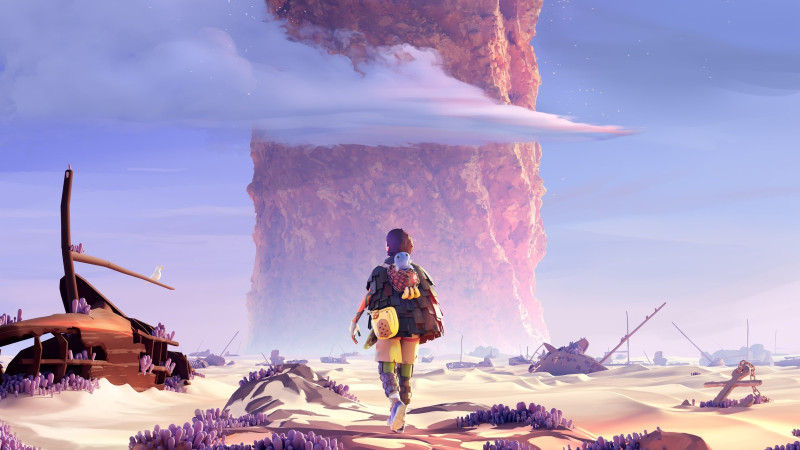Jusant is all about climbing a mountain, and Don’t Nod’s superb execution of this premise has propelled this small, meditative adventure to stand among the year’s finest titles. In my review, I wrote that the game’s “ingenious climbing system, beautiful art direction, and intriguing world-building, inching toward the top is worth the effort.” That effort can be attributed to Don’t Nod honing in on the game’s central mechanic, climbing, and building a fascinating world and lore around it. I spoke to the game’s lead designer, Sofiane Saheb, and art director, Edouard Caplain, to better understand how Don’t Nod spent over three years bringing Jusant to life.
Caplain states Jusant’s development began after Don’t Nod finished work on Life is Strange 2. After releasing another narrative-heavy experience with heavy, often depressing themes, the small team was eager to tackle something more lighthearted, smaller, and, most of all, different from the studio’s usual output. Don’t Nod turned to a few games for inspiration, the primary title being Journey. The 2012 adventure’s whimsical, enigmatic vibe and singular focus – walking to a mountain – provided a great example of the atmosphere and scope the studio aimed to achieve.
“Journey…it’s kind of a dreamy kind of game, it’s not reality,” says Caplain. “Everything is kind of chill…and it’s very positive. And next to the idea of climbing a big tower, we also wanted to make a game which [has] a good positive vibe. [Life is Strange] has some very heavy, heavy subjects which are hard to treat, and which are kind of heavy to even play. I wanted to make something much more lighter, much more positive.”
Don’t Nod drew atmospheric and mechanical inspiration from games such as Shadow of Colossus and Grow Up, but it also turned to literature. Saheb tells me Jusant’s premise is partly inspired by La Horde du Contrevent (The Backwind Horde), a French book written by author Alain Damasio, who also happens to be one of Don’t Nod’s founders. The book centers on a group of specialized explorers who embark on a search for the origin of the wind in an unforgiving landscape. Jusant centers on the protagonist’s search for water in a world that has mysteriously lost it, so the parallel is clear.
Saheb and Caplain state that Don’tNod developed Jusant’s climbing mechanics first, then formed the simple pitch of having players scale a tall tower. Everything else, such as the narrative, lore, and art direction, spun out of this core idea. Even though the mechanics lean towards realism, no one on the team had any real climbing experience at the start of development. It wasn’t until the game was in production that some designers began learning how to climb, which provided helpful insight into best/worst practices. But beyond this, Don’t Nod didn’t consult professional climbers because the goal was never to make Jusant a fully realistic simulation of mountain climbing. “We tried to have [a] balance between some arcade-y feels and something more involved,” says Saheb. He cites Getting Over It With Bennett Foddy as an example the team examined to achieve the right balance of simplicity and complexity in its climbing mechanics.
This focus resulted in Don’t Nod cutting ideas that, while cool on paper, proved too mechanically cumbersome. Saheb tells me that at one point, players could ride and control the beetle that appears after players reach the giant solar dial at the end of chapter three. The creature would whisk players to the caves in chapter four, but introducing totally new mechanics to facilitate this interrupted the game’s delicate pacing. Your watery companion Ballast, whose echo pulse transforms organic elements to players’ advantage, once had an ability that let players aim and fire a ball of its energy to trigger distant objects. After toying with this feature, the team concluded that climbing and shooting was too complicated and abandoned the idea. Saheb, in particular, took nailing the pacing and balancing very seriously, and as a result, it’s one of the elements he’s most proud of in the final product.

Jusant’s warm, flat, colorful palette and smooth geometry were another inspiration spurred by Journey, and Caplain refers to it as “simplified reality.” Landing on the look was a mission to ensure the environment clearly communicated climbing points such as ledges and handholds without pointing them out too obviously, which would take away the problem-solving process. Don’t Nod avoided the usual eye-catching platforming tricks, such as highlighting climbing points with something artificial like paint, and instead utilized more natural color shades to make important elements pop. Interestingly, despite the colorful look and stylized yet simplified graphics, Caplain states the team was adamant the game not look like a cartoon.
“Usually, when you simplify things, you can stylize it so it looks for kids and everything,” Caplain says “And we didn’t want to do a game that looks [like it’s] for kids.”
Setting Jusant in a fictional world allowed the team to get creative when it came to designing its desert environment, a biome that has the potential to be very one note from a presentational standpoint. It could use a variety of colors instead of the expected yellows, oranges, and reds while also populating areas with playful elements such as cute furry critters or bubble-like grass that float away when players step on them. The game is technically post-apocalyptic, which typically equates to a more dreary presentation, so Caplain says this is why the presence of nature, from the strange flora to the wildlife, was an important element of maintaining a sense of uplifting whimsy.
From the beginning, Don’t Nod wanted Jusant’s story to be open to interpretation. Much of its storytelling is told indirectly through diaries and lore notes players must largely seek out for themselves. The protagonist doesn’t emote beyond grunts; all you know about them is they’re a traveler, a clearly skilled climber, and, somehow, have a strange magical pet.
That leaves a lot of room for players’ imaginations to run wild, and because of this, Caplain says the team doesn’t have the answers to those questions either. “It’s just a traveler,” says Caplain. “The main point was a character you can easily relate to. Like, he had to be very bland so you can imagine it’s you and that you could be this protagonist.” Despite that somewhat disappointing answer, Caplain and Sahed are visibly amused when I share my theories about the protagonist’s origins and purpose. They’re just glad that people care enough to theorize in the first place.

Jusant has been well-received since its launch, garnering an 83 critical response on Metacritic. That’s an impressive feat for a more experimental title released in a year stacked with so many big triple-A hits, and it arrived at the end of a very crowded October, no less. For Saheb and Caplain, who have worked at Don’t Nod for a decade, the response has clearly moved them
“We are so happy,” says Caplain. “It’s overwhelming for us. It is very hard to release your game with all those studios releasing huge games. We were so happy.”
Don’t Nod recently released an update that added new approachability and accessibility options. That includes playing without the stamina meter and climbing using only the joysticks instead of gripping with the triggers. These helpful tools make an already chill experience even easier to grasp for those who need or desire it, which means more people are able to try their hand at reaching Jusant’s summit.
Saheb and Caplain say they’ve learned a lot of lessons making Jusant, but whether or not they’ve walked away with a newfound desire to scale a real mountain themselves remains to be seen.
“I had a little son in between, so no time for that,” Saheb laughs.








